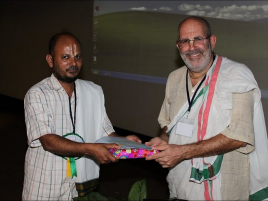Devotee Scholars Attend Cosmology Conference in Bangalore
By Basu Ghosh Das | Дек 12, 2010

A “Global Conference on Cosmologies – Perspectives of the Universe” took place from December 2-4, 2010, at Bangalore. The conference was organized by the Srinivas Jyotish Vigyan Research Foundation, founded and headed by Sri Dev Nath Acharya, and headquartered at Srirangam, Tamil Nadu.
The conference venue was the auditorium of the National Institute of Advanced Studies (NIAS), located on the campus of the famed Indian Institute of Science, established more than a century ago.
The conference was inaugurated by Karnataka Chief Minister, the Honorable Sri B.S. Yeddyurappa. In his inaugural address he expressed his pleasure of being present at the conference as well as expressing the importance of the knowledge of the ancient Indian literatures.
The keynote address was presented by Dr. G. Madhavan Nair, the former chairman of the Indian Space Research Organization, ISRO, the Indian Government space exploration agency. He presented a slideshow depicting ISRO’s “Chandrayaan” project that launched an unmanned research vehicle into outer space, and its findings.
The rest of the 3-day conference was a series of sessions in which various invited academics discussed Cosmology in its various aspects from different perspectives.
The list of prominent speakers included Professor B. V. Sreekantan, the distinguished High Energy Astrophysicist, Dr. Smita Jha from the humanities department at IIT Rourkela, , Dr. Jarita Holbrook from UCLA, Rasaraj Das, Director of the Bhaktivedanta Institute, Prof. M.A. Lakshmi Thathachar of the Samskrit Foundation, Prof. M. Venkata Krishnan, Head of the Dept. of Vaishnavism, Madras University, Sri. R. Ganesh, “shata avadhani”, Prof. K. Ramasubramanian, Presidential Awardee from the Humanities Department at IIT, Bombay, and Dr. Priyadarshana Jain, Head, Dept. of Jainism, Madras University.
Three ISKCON devotees, Basu Ghosh Das (President, ISKCON Baroda), Rasaraj Das (aka Prof. Ravi Gomatam, Director, Bhaktivedanta Institute, as well as Director for the newly formed Institute for Semantic Information Sciences and Technology, Berkeley/Bombay) and Antardwip Das (Bhaktivedanta Academy, Sridham Mayapur), were invited to speak, and each gave a talk and submitted written papers at the conference.

Rasaraja’s talk was titled “Toward a possible new mathematical conception of space to understand Puranic cosmology scientifically.” He started by pointing out that Bhagavat descriptions of cosmology seem to defy common sense perception and modern scientific observations, as in describing the height of the Himalayas as 80,000 miles (SB 5.6.19).
He then showed how his own original research in developing a new field of physics called Macroscopic Quantum Mechanics (MQM) opens the way for a new conception of space in both scientific and commonsense thinking that can fit Bhagavat descriptions nicely. One of the attendees, a physics teacher, later said that while many other attempts to link Vedic cosmology to modern science were weak, “your talk alone made attending the conference worthwhile for me.”
Basu Ghosh Das, who’s talk was entitled “The Cosmos and it’s depiction in the Temple of the Vedic Planetarium: presenting the Bhagavat concept of the Universe to the World” first of all presented a short movie displaying the design concepts of the Temple of the Vedic Planetarium at Mayapur.
He then explained how ISKCON was founded to propagate the vedic concepts, knowledge and dharma around the world. ISKCON’s founder-acharya Srila Prabhupada conveyed the clear conception of the origin of the universe based on both the Mahabharata – in the Bhagavad-gita – and the Srimad Bhagavatam, the Bhagavata Mahapurana.
He also commented that Prabhupada and the vedic tradition teaches that the Vedas, Itihasas and Puranas are true history and not mythology. He expressed surprise that a number of Indian scholars accept the Western contention that this is all false, and that they accept the “wild speculation” of the “big bang” theory of the creation of the Universe.
He presented more than sixty slides showing the Bhagavat conception of the creation and the universe, Srila Prabhupada’s desire to construct the Temple of Vedic Planetarium (ToVP), Srila Prabhupada inspiring Ambarish Das (Alfred B. Ford) to finance the ToVP, and pictures of the ongoing construction of the ToVP at Mayapur and section plans of the ToVP. He also presented a few interesting details about the construction of the ToVP, such as the fact that the ToVP will be supported by two thousand seven hundred pilings that have already been made, and that in the pilings stainless steel was used instead of regular steel, etc.
Antardwip Das spoke on the topic: “On reconciling Puranic cosmologies and Surya Siddhanta.” He pointed out that while Puranic cosmologies give a description that presupposes subtler planes of perception, the Siddhanta texts describe a cosmology more akin to present common sense perception, and how both descriptions can be reconciled.

Rasaraj Das chaired one of the nine, one and a half hour sessions, and Basu Ghosh Das also chaired one session.
Some of the other topics presented at the conference: African Cosmology, Pre-historic observational astronomy in India, Creation – Shrishti Vignana [presenting the vedic concept of cosmology], Physics of Rotating and Expanding black-hole universe, Metaphysics and modern Science, Cosmogony and space from rock arts, Cosmology of Sankhya-yoga, Reconciling aspects of Darshanas [the six ancient Indian philosophies] and modern physics, The esoteric cosmology of the Vedas, Ancient Indian Cosmology – observational perspectives, How did Indian Astronomers predict the celestial events accurately?, Cosmology in ancient art, Cosmology in Sanskrit folk literature, Indian astronomical tables with special reference to the South Indian practices, Cosmic geometries of holy places of North India, Jain Cosmology and it’s application for conscious evolution, Cosmology and Agama [shastras], Cosmology according to the Puranas, and Cosmology and Sankhya.
Concluding the program, the Honorable former Justice of the Supreme Court of India, Sri M.N. Venkatachaliah gave the valedictory address. Thereafter, concluding remarks were presented by the NIAS Director, Prof. V.S. Ramamurthy.
The proceedings of the conference containing all the papers will be published in the near future by the organizers.















